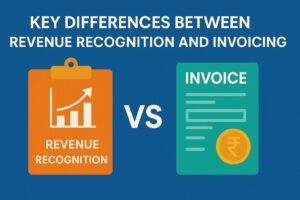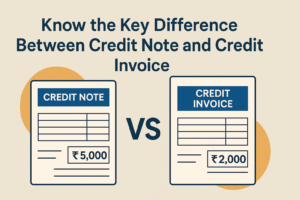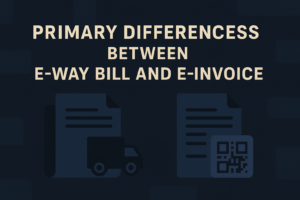What’s the Difference Between a Work Order and an Invoice?
- 25 Nov 25
- 9 mins
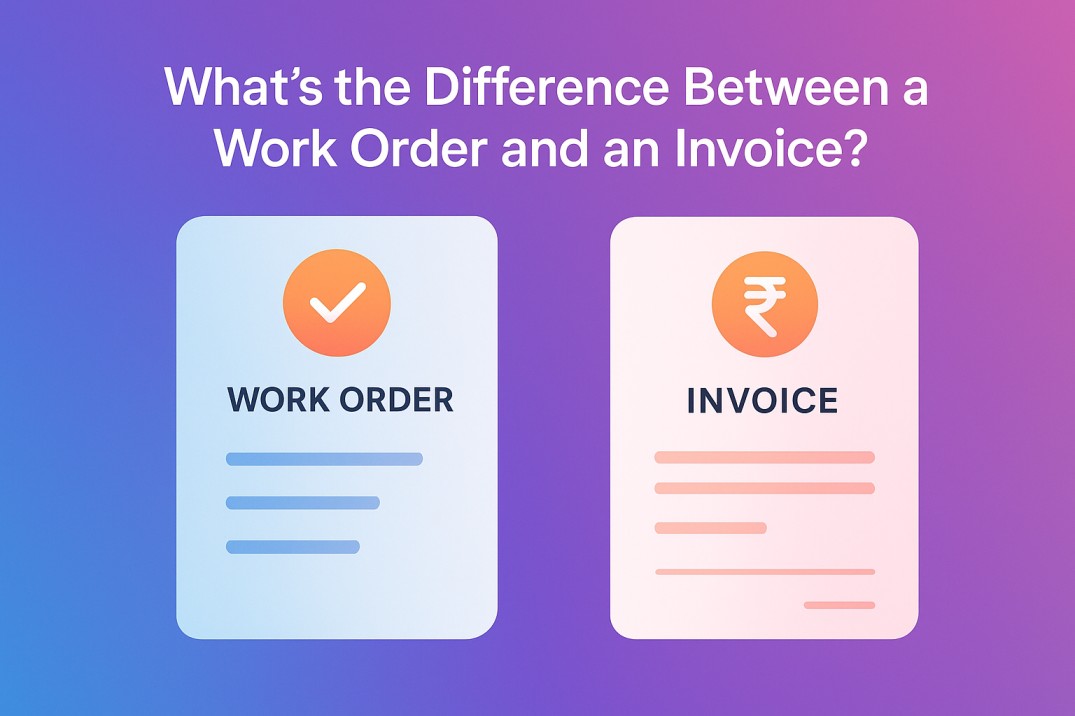
What’s the Difference Between a Work Order and an Invoice?
Key Takeaways
- The main difference between work order and invoice is that a work order starts the job while an invoice ends it with a payment request.
- Work orders outline tasks, resources, and deadlines before work begins, ensuring smooth project execution.
- Invoices list costs, taxes, and payment terms after work is completed to support billing and financial tracking.
- Understanding the difference between work order and invoice helps avoid confusion between job instructions and payment obligations.
- Both documents improve transparency, record-keeping, and workflow efficiency across service and product-based businesses.
Have you ever wondered why your service provider gives you a work order first and an invoice later? Though both are essential business documents, they serve entirely different roles. The difference between a work order and an invoice can impact everything from workflow efficiency to timely payments.
In fact, over 72% of goods and service companies now rely on digital work orders to streamline operations. Whether you are a business owner or a curious customer, understanding this difference can save time, avoid confusion, and improve transparency.
So, let us break it down clearly and simply.
What is a Work Order?
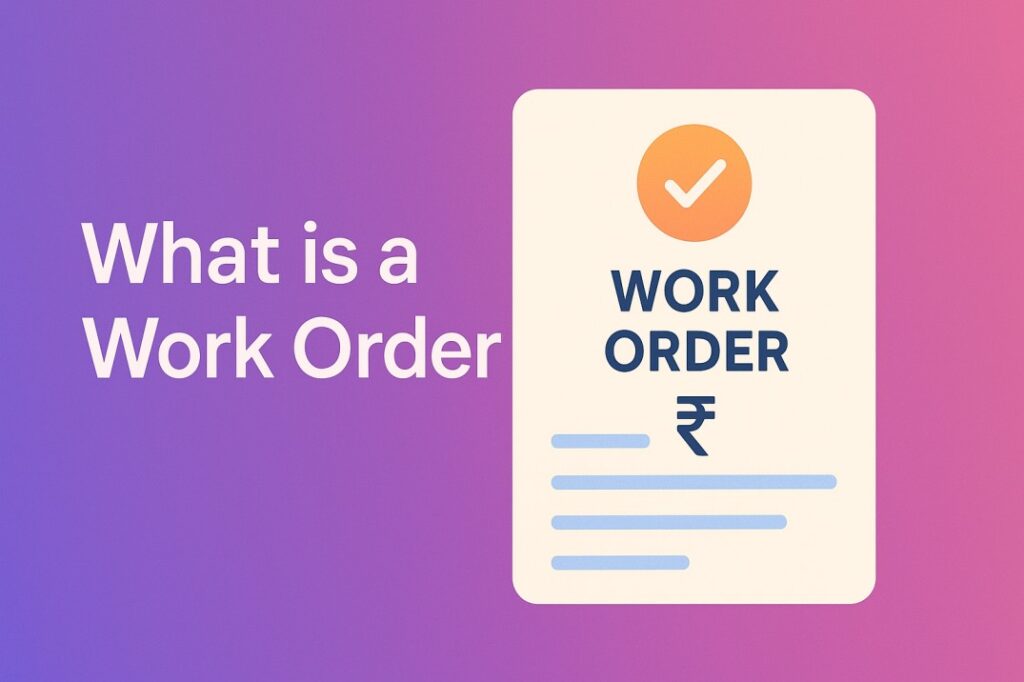
A work order is a document outlining specific instructions, tasks, and details related to a particular project within an organisation. It is a formal directive that provides essential information to contractors or employees responsible for executing the work.
Generally, supervisors, project managers, or coordinators generate work orders to offer a clear roadmap for task execution.
The format of a work order can vary. Some are simple, single-page documents, while others may be more detailed and span multiple pages. Regardless of the format, they usually include deadlines, technical specifications, and resource allocations.
The primary purpose of a work order is to ensure clarity, streamline workforce management, and maintain consistency across projects.
What is an Invoice?
An invoice is a bill sent by a seller to a buyer after products or services have been delivered. It includes the date, item or service details, quantity, price, and total payable amount. It also outlines payment terms and deadlines.
Let us consider an example to understand this better. A company sends an invoice for ₹10,000 to a client upon completing a social media campaign.
Invoices are important for tracking income and record-keeping for tax purposes. Reports show that by 2022, 64% of companies completed more than half of their B2B payments electronically, although some still use paper invoices.
An invoice generally includes:
- Invoice number
- Date of invoice
- Work order number
- Price of the good purchased
- Quantity of purchased goods and services
- Discounts, if applicable
- Taxes, if applicable
- Total due amount
- Name of buyer and address
- Name of seller and address
- Payment terms
- An authorised signature
- Due date or deadline
Differences Between Invoices and Work Orders
The table below displays the key difference between work order and invoice:
| Parameters | Work Order | Invoice |
| Purpose | Thoroughly verifies a task description or job before beginning | Requests for payment after completion of job |
| Timing | A work order is created before beginning work on a job | Creates an invoice after finishing work |
| Inclusions | Includes details of the job, deadline, materials, scope, technician, and others | Includes costs, taxes, terms of payment, start date and due date |
| Used By | Maintenance, operations, production teams, and services | Billing, accounts, and finance departments |
| Involvement of customers | Customers might sign or provide approval before beginning work | After reviewing an invoice, the customer makes the payment |
| Impact | Used for job tracking and scheduling | Used for reviewing revenue records and financial reporting |
| Example | A car mechanic receives a work order for repairing the car’s brakes | Once repaired, the customer receives an invoice amount of Rs. 3,500 |
7 Types of Work Order You Must Know

- Standard Work Order: This is a basic work order for a standard job that includes standard mowing, trimming, or maintenance work order.
- Emergency Work Order: An emergency work order applies well for completing any emergency repair job or unplanned services that need immediate attention. Examples include a bursting pipe.
- Preventive Maintenance Work Order: This is categorised as a time-based work order for completing any preventative work, such as cleaning the chimney or replacing HVAC filter.
- Service Request Work Order: A Service request work order is another type of work order when a client reaches out for a work request outside of what you have already offered. For example, if a cleaning business is requested for steam cleaning furniture.
- Stop Work Order: For this, a formal notice is issued for stopping work on the job because of violating safety conditions, permitting issues, and other contract disputes.
- Corrective Work Order: A corrective work order is an order for repairing any completed work performed previously that includes fixing a loose board.
- Change Order: This denotes the issuance of a document for making relevant changes to the initial contract or agreement between the client and service provider. For instance, if there is a change in the scope of work or some relevant material goes out of stock.
How Work Orders are Used?
Work orders are used similarly to the method of use of purchase orders. They enable organising work and improving communication. Here are some common uses of work orders:
1. Maintenance Services
Building managers need work orders for repairing purposes that include electrical, plumbing, and air conditioning.
Example: A resident has reported a broken water pipe. To solve the issue, a work order is created with a detailed job description for the plumber.
2. Field Services
Pest control, electricians, and cleaning services review work orders before visiting the client's address.
Example: A cleaning company gets a work order for conducting deep cleaning at a school.
3. Manufacturing
The majority of companies take the help of work orders to begin the production process or maintenance of equipment.
Example: A well-recognised factory receives a work order for manufacturing about 1000 plastic bottles.
4. IT and Tech Support
In IT departments, work orders are issued for fixing any work order management software and hardware-related issues.
Example: An employee in a company raised a request for repairing a laptop, and IT recorded it as a work order.
9 Ways of Using Invoices in Business
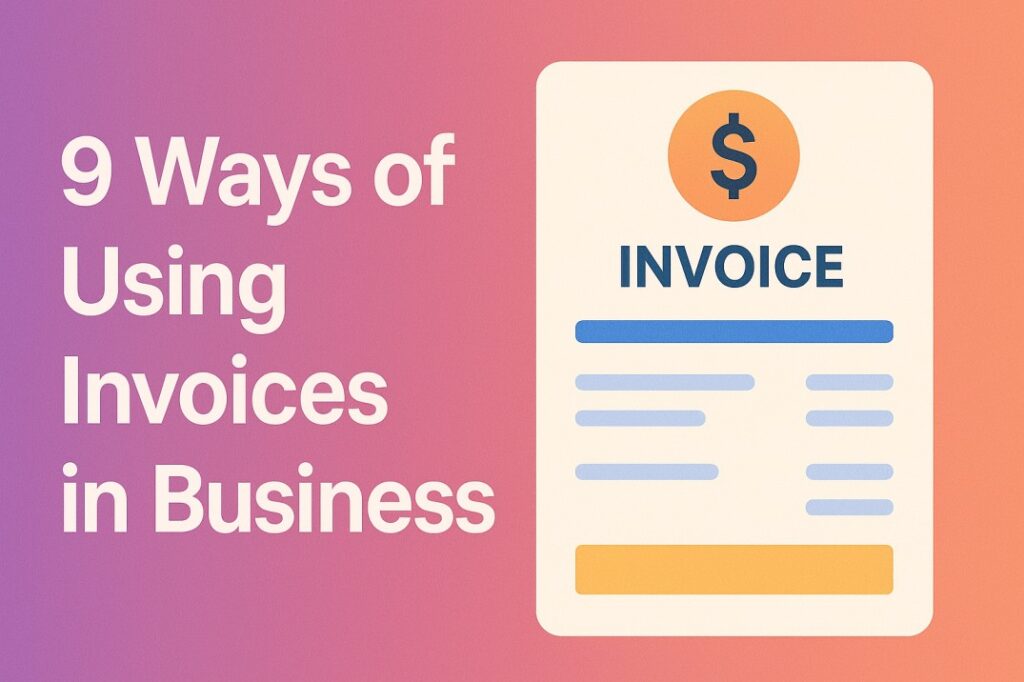
The uses of an invoice include:
1. Payment Request
Invoices are bill statements with an outline of the total amount due and payment terms. This boosts cash flow with on-time payment of bills.
2. Accounting
For bookkeeping purposes, invoices play a crucial role. In accounting department, invoices provide a detailed sales orders record to enable businesses to keep a track record of their revenue and manage finances efficiently.
3. Sharing Information
Invoices share detailed information about goods and services provided that includes a description of the order, quantities, and payment terms. Maintaining this transparency allows customers to understand the purpose of billing.
4. Sales Tracking
Invoices help in the close monitoring of sales tax trends and track performance over time. Reviewing your invoices thoroughly, you can identify the peak period of sales and adjust your strategies.
5. Payment Monitoring
Invoices maintain a record of payments with outstanding amounts. This enables managing accounts payable received and accordingly takes a follow-up on payments overdue.
6. Legal Records
Invoices generalise the agreement between the buyer and seller about the sale of goods and services. It serves as a legal document and provides evidence of agreeable terms. Invoices also guide in settling legal issues relating to the transaction.
7. Easy Filing of Taxes
Invoices are essential for tax-related purposes. It provides documentation for accurately reporting income and deductions of the claim amount. This makes the tax filing process smoother and straightforward.
8. Business Analytics
With proper analysis of invoice matching data, you can gain detailed insights into performance of business. This information guides through decision-making and points out areas of improvement.
9. Inventory Tracking
Invoices enable easy tracking of stocks, which is applicable for businesses with inventory. In an invoice, you get detailed data of goods being sold, assisting in maintaining an effective inventory management.
Similarities Between Invoices and Work Orders
Both work order and invoice are different but comprise common features. Both help in servicing, repairing, and product-based businesses. The key similarities include:
- Business Transactions
Work orders and invoices are a crucial part of business transactions, from requesting services to payment. For example, a car repair shop needs a work order for starting the repair process and an invoice for collecting payment later on.
- Details of Job or Service
Both invoices and work orders mention products used, services offered, quantity, and labor hours. Mentioning clearly the information prevents confusion and maintains a clear record.
- Progress Tracking and Responsibility
Both help in the easy identification of which team or employee can handle tasks efficiently and creating accountability.
- Record Keeping
Businesses are often found to be using both the documents for maintaining the accuracy of records of works done and the amount of money earned. This proves beneficial during budgeting, audits, and financial planning.
- Digital Management
Nowadays, there are many companies using software for creating and managing both invoices and work orders. Use of tools such as Pice, Zoho, and FreshBooks simplifies the entire process and reduces the chances of errors.
- Legal and Tax Purposes
Both these documents are valid proof of work and payment. Alongside this, it helps in resolving disputes with the proper submission of documents during tax filing.
Overall, reports reveal that 68% of small businesses choose invoices and work orders for streamlining operations and reducing delays in payment processing.
💡For your invoice generation needs, use the PICE App.
Conclusion
The key difference between work order and invoice lies in their timing and purpose. A work order is issued before a job begins to outline tasks, resources, and deadlines. In contrast, an invoice is sent after the work is completed to request payment.
While work orders ensure effective task planning and tracking, invoices support accurate billing and cash flow management. Whether you are running a repair service, cleaning business, or manufacturing unit, using both documents is essential to streamline operations, maintain records, and enhance customer satisfaction.
 By
By 





